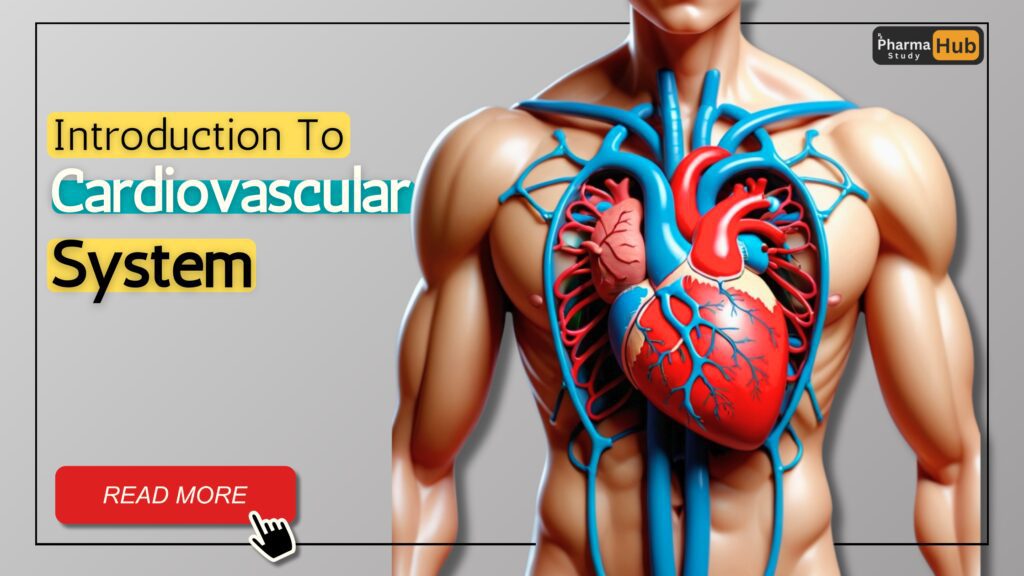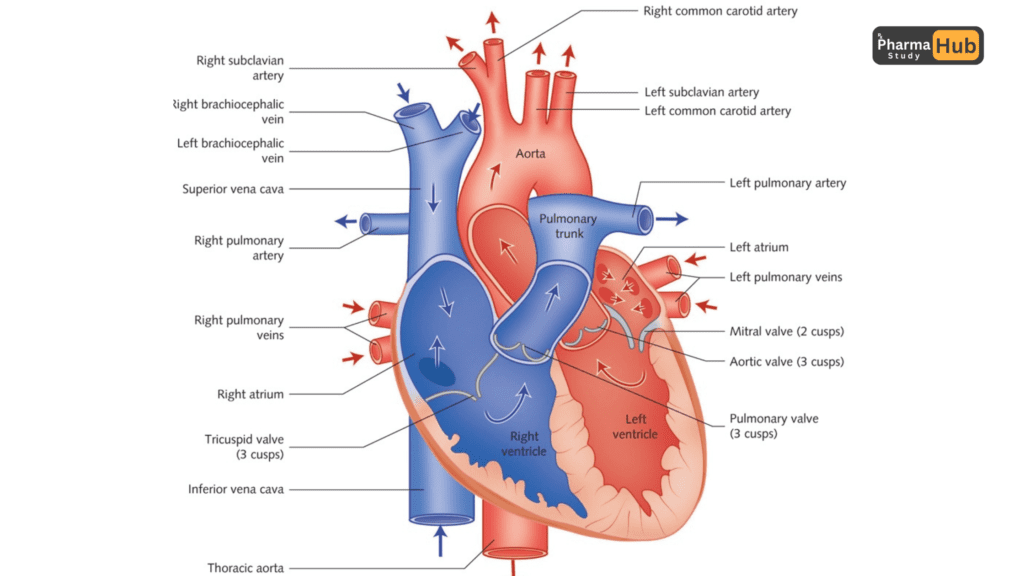Introduction To Cardiovascular System
Every cells in our body need oxygen to stay alive, and blood is the only way to deliver oxygen to all the cells of the body. And the work of delivering blood throughout our body is done by only one organ and that is the — heart. The heart is a structurally simple organ, which serves to supply blood to all our blood vessels. The blood, heart, and blood vessels together form a system which is known as Cardiovascular system.

Table of Contents
What is Cardiovascular System
Cardiovascular System is the system which fulfils the transportation need of the body. This system contains Heart, Blood and the Blood Vessels.
The cardiovascular system is essentially your body’s distribution system. It’s a network of organs and vessels that work together to deliver blood throughout your body. This blood carries vital substances, such as oxygen and nutrients, to your cells, and removes waste products, such as carbon dioxide.
The cardiovascular system works in a continuous loop. The heart pumps oxygenated blood from the left ventricle into the arteries, which branch out to deliver oxygen and nutrients to all parts of the body. Deoxygenated blood then returns to the heart through the veins, entering the right atrium. The heart then pumps this blood to the lungs to pick up oxygen and release carbon dioxide, before sending freshly oxygenated blood back to the body. This continuous circulation is essential to maintaining life.
Why is the Cardiovascular System Important?
The cardiovascular system is crucial for:
- Oxygen and Nutrient Delivery: Supplying oxygen and essential nutrients to cells and tissues.
- Waste Removal: Carrying carbon dioxide and metabolic waste products away from tissues.
- Temperature Regulation: Helps in maintain body temperature by distributing heat.
- Hormonal Transport: Circulating hormones to the target organs for proper functioning.
- Protection: Supporting the immune system by transporting white blood cells and antibodies to our body.
Main Components of the Cardiovascular System
Here we will try to understand a little about the components of the cardiovascular system. the main components of the cardiovascular system are:
The Heart: This muscular organ acts as a pump, contracting rhythmically to push blood through the circulatory system. It has four chambers: two atria (receiving chambers) and two ventricles (pumping chambers).
Blood Vessels: These are like the roadways of the cardiovascular system. There are three main types of the vessels:
Arteries: These carry oxygen rich blood away from your heart to the rest of the body parts. They are thick elastic walls to withstand the pressure of the pumping heart.
Veins: These carry the deoxygenated blood back to the your heart. They have thinner walls than the arteries and often contain valves to prevent from flowing backward.
Cappillaries: These are tiny, thin wall vessels that connects arteries and veins, where they exchange the oxygen, nutrients and waste products takes place between the blood and the body’s tissues.
Blood: This is the fluid that transported through the blood vessels. It contains Red Blood Cells(carry oxygen), White Blood Cells (fight infections), Platelets (helps in blood clotting), and plasma (watery content fo the blood)

How Does It Work?
The cardiovascular system is a closed-loop system, constantly circulating blood to deliver oxygen and nutrients while removing waste products. The heart has a powerful muscle it acts as the pump, which is divided into four chambers: two atria receive blood and two ventricles pump it out. The right side receives deoxygenated blood from the body and sends it to the lungs for oxygenation. The left side receives this oxygenated blood from the lungs and pumps it to the rest of the body through a network of arteries.
Arteries, with their thick, elastic walls, carry oxygenated blood away from the heart under high pressure. This pressure gradually decreases as the arteries divide into smaller arterioles and finally into capillaries, the smallest blood vessels. Capillaries are the sites where the vital exchange of oxygen, nutrients, and waste products between the blood and the body’s tissues takes place. After this exchange, the now deoxygenated blood enters the venules, which merge into larger veins.
Veins, with thin walls and valves to prevent backflow, return deoxygenated blood to the heart, completing the circuit. This constant flow, driven by the heart’s rhythmic contractions, ensures that every cell in your body receives the oxygen and nutrients it needs to function and that waste products are removed efficiently. The entire process is controlled by the nervous and endocrine systems to maintain balance and respond to the body’s changing needs.
Fun Fact 😲
- Blood makes up 8% of your total body weight, and an average adult male has 8⅘–10½ pints (5–6 liters) of blood in his body, while an average female has 7–8⅘ pints (4–5 liters).
- Red blood cells survive in the body for only 120 days. They are produced in the red bone marrow of long bones and are released into circulation at the rate of approximately two million red blood cells per second.
- Your heart is approximately the same size as your closed fist and weighs only about 9–11 oz (250–300 g).
- A heart beats approximately three billion times in an average lifetime of 70 years, with never a moment’s rest.
- The word “coronary” comes from the word corona, which means “crown,” and the coronary blood vessels encircle the heart just as a crown encircles the head.
- When your body is at rest, your heart can circulate your entire blood content throughout your body within one minute. If you are exercising, it can do this in as little as ten seconds.
- Because the walls of arteries are quite thick they remain open when cut, while the thinner walls of veins collapse if cut.
- The diameter of the aorta is approximately the same as that of your thumb.
Conclusion
The cardiovascular system is a complex and important part of the human anatomy. In the next post, we’ll take a deeper dive into the anatomy and physiology of the heart, understanding how it functions as the powerhouse of the circulatory system.
Attention Please!
I hope you found this content informative and engaging. If you enjoyed reading and believe it could benefit others, please take a moment to share it with your friends, colleagues, or anyone who might find it helpful.
Your feedback matters! If you have any suggestions or ideas to improve this content, feel free to reach out. Together, we can create even more valuable resources. Thank you for your support!
1 thought on “Understanding the Cardiovascular System: An Essential Guide”